Papers by Audrius Pukalskas
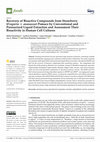
Foods
Pressing strawberries for juice generates large amounts of pomace, containing valuable nutrients ... more Pressing strawberries for juice generates large amounts of pomace, containing valuable nutrients and therefore requiring more systematic studies for their valorization. This study compared conventional solid-liquid (SLE) and pressurized liquid (PLE) extractions with ethanol (EtOH) and H2O for the recovery of bioactive compounds from strawberry pomace. The composition and bioactivities of the products obtained were evaluated. Among 15 identified compounds, quercetin-3-glucuronide, kaempferol-3-glucuronide, tiliroside, ellagic, malic, succinic, citric and p-coumaric acids were the most abundant constituents in strawberry pomace extracts. SLE-EtOH and PLE-H2O extracts possessed strong antioxidant capacity in DPPH• and ABTS•+ scavenging and oxygen radical absorbance capacity (ORAC) assays. Cytotoxicity, antiproliferative and cellular antioxidant activities in human cells of PLE-EtOH and PLE-H2O extracts were also evaluated. PLE-EtOH and PLE-H2O extracts possessed strong antioxidant acti...
Plasma Processes and Polymers
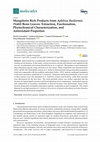
Molecules
Aphloia theiformis is traditionally used in Mauritius, Madagascar, and Reunion Island for treatin... more Aphloia theiformis is traditionally used in Mauritius, Madagascar, and Reunion Island for treating several diseases. In this study, various extraction solvents and schemes were applied for the recovery of antioxidant rich fractions from the leaves of A. theiformis. The products were evaluated for their antioxidant capacity using well known in vitro assays. Major compounds were characterized by UPLC–QTOF–MS. Hydrophilic extracts of A. theiformis demonstrated strong antioxidant properties, which are comparable with the synthetic antioxidant Trolox. UPLC analysis confirmed mangiferin as the main secondary metabolite of A. theiformis. Tormentic and hydroxytormentic acids as well as their isomers were also abundant in A. theiformis extracts and fractions, while their amounts were determined for the first time. The most potential extract was further separated into the fractions by liquid-liquid extraction and by precipitation at low temperature. Antioxidant capacity and composition of sec...
The Journal of Supercritical Fluids
Industrial Crops and Products
Journal of CO2 Utilization
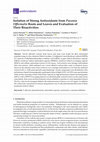
Antioxidants
Paeonia officinalis extracts from leaves and roots were tested for their antioxidant potential us... more Paeonia officinalis extracts from leaves and roots were tested for their antioxidant potential using in vitro chemical (Folin-Ciocalteu, 2,2-diphenyl-1-picrylhydrazyl radical (DPPH), 2,2′-azino-bis-3-ethylbenzothiazoline-6-sulfonic acid (ABTS), oxygen radical absorbance capacity (ORAC), hydroxyl radical antioxidant capacity (HORAC), hydroxyl radical scavenging capacity HOSC)) and cellular antioxidant activity (CAA) assays. Leaf extracts were stronger antioxidants than root extracts, while methanol was a more effective solvent than water in chemical assays. However, the selected water extract of leaves was a stronger antioxidant in CAA than the methanol extract (0.106 vs. 0.046 µmol quercetin equivalents/mg). Twenty compounds were identified by ultra performance liquid chromatography-quadrupole-time-of-flight (UPLC-Q-TOF) mass spectrometer, while on-line screening of their antioxidant capacity by high performance liquid chromatography (HPLC) with a DPPH•-scavenging detector revealed ...
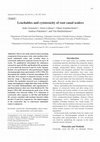
Journal of Oral Science
This in vitro study aimed to detect leaching components from an epoxy resin-and a methacrylatebas... more This in vitro study aimed to detect leaching components from an epoxy resin-and a methacrylatebased endodontic sealer and correlate them to cytotoxicity induced by material extracts for up to 36 weeks. We qualitatively determined the substances released by aged AH Plus and RealSeal SE specimens at seven intervals between 0 and 36 weeks. Quantification was performed by ultra-performance liquid chromatography/mass spectrometry (UPLC/MS). We determined the viability of murine macrophage J774 cells after 24 h exposure to material extracts, at each interval, using a fluorescence staining/microscopy method. The leachables detected were 1-adamantylamine and bisphenol A diglycidyl ether from AH Plus and N-(p-tolyl) diethanolamine and caprolactone-2-(methacryloyloxy) ethyl ester from RealSeal SE. The largest UPLC/MS chromatogram peak areas of the leachables were detected within 72 h. Induction of cytotoxicity after exposure to AH Plus and RealSeal SE extracts coincided with leachant detected within the first 72 and 24 h, respectively. The clinical impact of the cytotoxicity due to resin-based endodontic sealers is unknown.
Journal of Functional Foods
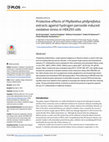
PLOS ONE
Phyllanthus phillyreifolius, a plant species indigenous to Reunion Island, is used in folk medici... more Phyllanthus phillyreifolius, a plant species indigenous to Reunion Island, is used in folk medicine for treating diarrhea and as a diuretic. In the present study acetone and hydroethanol extracts of P. phillyreifolius were evaluated for their cytotoxicity and antioxidant effects using in vitro (TPC, ABTS, DPPH, FRAP, ORAC) and in cellulo (MTT, DCFH-DA, RT-qPCR) assays. Major compounds were evaluated using UPLC-QTOF-MS. MTT cell viability assay showed low cytotoxicity of extracts towards human embryonic kidney 293 (HEK293) cell line. Both extracts were rich in polyphenols (mainly ellagitannins) and showed high antioxidant potential and intracellular ROS decreasing effect. Preconditioning of HEK293 cells with extracts influenced gene expression of antioxidant enzymes, however ROS level decreasing effect was more related to their capacity to scavenge free radicals and with their reducing power. Strong antioxidant activity of extracts as well as the presence of geraniin supports the use of P. phillyreifolius in traditional medicine.
Industrial Crops and Products
Food and Bioproducts Processing
Industrial Crops and Products, 2016
Journal of Functional Foods, 2016

Food Chemistry, 2017
Ten Salvia species, S. amplexicaulis, S. austriaca, S. forsskaolii S. glutinosa, S. nemorosa, S. ... more Ten Salvia species, S. amplexicaulis, S. austriaca, S. forsskaolii S. glutinosa, S. nemorosa, S. officinalis, S. pratensis, S. sclarea, S. stepposa and S. verticillata were fractionated using supercritical carbon dioxide and pressurized liquid (ethanol and water) extractions. Fifteen phytochemicals were identified using commercial standards (some other compounds were identified tentatively), 11 of them were quantified by ultra high pressure chromatography (UPLC) with quadruple and time-of-flight mass spectrometry (Q/TOF, TQ-S). Lipophilic CO2 extracts were rich in tocopherols (2.36-10.07mg/g), while rosmarinic acid was dominating compound (up to 30mg/g) in ethanolic extracts. Apigenin-7-O-β-d-glucuronide, caffeic and carnosic acids were quantitatively important phytochemicals in the majority other Salvia spp. Antioxidatively active constituents were determined by using on-line high-performance liquid chromatography (HPLC) analysis combined with 2,2'-diphenyl-1-picrylhydrazyl (DPPH) assay (HPLC-DPPH). Development of high pressure isolation process and comprehensive characterisation of phytochemicals in Salvia spp. may serve for their wider applications in functional foods and nutraceuticals.
LWT - Food Science and Technology, 2017

Journal of Food Science, 2016
Apples (Malus domestica L.) are the most common source of phenolic compounds in northern European... more Apples (Malus domestica L.) are the most common source of phenolic compounds in northern European diet. Besides pectins, dietary fibers, vitamins, and oligosaccharides they contain phenolic compounds of different classes. Apple powders are convenient functional forms retaining significant amounts of phenolic antioxidants. In this study reducing and radical scavenging profiles of freeze-dried powders of "Aldas,ˮ "Auksis,ˮ "Connel Red,ˮ "Ligol,ˮ "Lodel,ˮ and "Rajkaˮ were determined and phenolic constituents were identified using ultra high-performance liquid chromatography coupled to quadrupole and time-of-flight mass spectrometers. A negative ionization mode was applied and seventeen compounds: phenolic acids (coumaroylquinic, chlorogenic), flavonoids (quercetin derivatives), and procyanidin derivatives (B1, B2, and C1) were identified in all tested apple samples. Total values of Trolox equivalents varied from 7.72 ± 0.32 up to 20.02 ± 0.52 and from 11.10 ± 0.57 up to 21.42 ± 0.75 μmol/g of dry weight of apple powder in FRAP (ferric reducing antioxidant power) and ABTS (2,2-azinobis-(3-ethylbenzothiazoline-6-sulfonic acid) postcolumn assays, respectively. The greatest Trolox equivalent values were determined for apples of "Aldasˮ cultivar. Chlorogenic acid and procyanidin C1 were the most significant contributors to total reducing and radical scavenging activity in all apple cultivars tested, therefore they could be considered as markers of antioxidant activity.

Uploads
Papers by Audrius Pukalskas